Welder Dies During Welding Repair Inside of Cargo Tank Compartment
Michigan Case Report: 06MI188
Summary
On November 16, 2006, a 27-year-old male welder was killed while performing MIG welding repairs to the inside of a cargo tank that previously held diesel fuel. The four-compartment tanker was rinsed with steam and cooled, and then transferred into the work area. The decedent placed a ventilation hose into Compartment #4 by opening the ten-inch fill lid of the portal covering. After visually checking the outside of the tanker to confirm the leak location, the decedent removed the portal cover for Compartment #3 and transferred the ventilation hose from Compartment #4 to Compartment #3. The decedent did not open the portal covers for compartments #1 and #2. With the blower hose operational, the decedent entered Compartment #3 on four different occasions; once to check the Compartment for the leak location, once to perform grinding to prepare the leak location for welding repair, and twice to perform welding. It is unknown if the decedent conducted air monitoring. After entering Compartment #3 for the fourth time, vapors from Compartment #4 ignited during the welding in Compartment #3 and an explosion occurred (Figure 1). The decedent died at the scene.
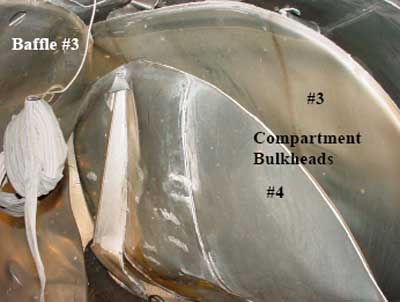
|
|
Figure 1. Damage to tanker baffle #3 and bulkheads #3 and #4, viewed through Compartment #3 portal hole facing toward the front of the tanker
|
Recommendations:
- Employers should identify areas that are classified as a confined space and meet the requirements of a permit-required confined space (PRCS). They should then develop a written PRCS program if employees will be entering the space.
- The written PRCS should include: 1) a procedure to document boiler operation and tanker cleaning, 2) a requirement for atmospheric monitoring and forced air ventilation in adjacent compartments when conducting hot work, such as welding, within a tanker compartment, and 3) a hot work permit for confined spaces.
- Employers should review welding practices to ensure proper welding techniques are used.
- Bulk transport trade organizations should develop a sample tank cleaning procedure that addresses the safety and health issues inherent in the tank cleaning process and welding performed to repair leaks.
Introduction
On November 16, 2006, a 27-year-old male welder was killed while performing welding repairs on the inside of a cargo tank that previously held diesel fuel. The Michigan Occupational Safety and Health Administration (MIOSHA) personnel received the fatality report on their 24-hour-a-day hotline on November 16, 2006. MIOSHA notified MIFACE the same day. The MIFACE researcher interviewed the company president on June 12, 2007 at the company headquarters. The president took the MIFACE researcher on a tour of the facility and permitted the researcher to take pictures of the top of a similar liquid cargo tank, the cargo tank washing facility (Figure2) and the air blower used on the day of the incident (Figure 3). During the course of writing this report, the death certificate, medical examiner’s report, police report and MIOSHA file and citations were reviewed. The pictures used in Figures 1, 4, 5, and 6 are courtesy of the MIOSHA file.
The firm fabricated, repaired, and maintained liquid cargo tanks. The firm had been in business for 28 years and employed 10 individuals. The decedent had been employed as an hourly, full-time employee for 10 months. All employees worked a nine-hour day, from 7:00 a.m. to 4:30 p.m. The decedent had at least five years experience as a welder.
The company had a written health and safety program, including a confined space program. MIOSHA deemed the confined space program insufficient. The company employed a private outside consultant to assist in the development and implementation of their safety program. An entry-level mechanic was assigned to oversee safety and health issues in the plant. However, the employee responsible to oversee the safety and health issues reported to MIOSHA that he did not know what his specific duties were under the permit required confined space program. The firm had a health and safety committee comprised of both hourly and salaried employees. The health and safety committee met monthly. Safety meetings were held as necessary with employees. The firm provided on-the-job training, and the safety consultant provided all “formal” training. The firm did not have a written disciplinary procedure in place for violations of the company’s health and safety program.
The employer had evaluated the workplace and determined that the tanker trucks were confined spaces. The firm had three classifications for confined spaces: non-permit, Hazardous Atmosphere Only, and Permit Required. The tanks were classified as Hazardous Atmosphere Only. MIOSHA determined that this classification was an inaccurate classification because the tanks and tank processing included, but was not limited to, residual flammable liquids, elevated temperatures due to steam cleaning process and entrapment behind baffles. The presence of these hazards made the tanks a permit-required space. MIFACE personnel did not review the employer’s confined space program; therefore it is unknown what a Hazardous Atmosphere Only classification designated and what the requirements were for entry into a Hazardous Atmosphere Only space.
MIOSHA General Industry Safety and Health personnel issued the following Serious citations, all for violations of the MIOSHA Permit-Required Confined Spaces, Part 490, 1910.146 standard to the employer at the conclusion of its investigation:
- 1910.146(c)(1): The employer did not determine the presence of permit-required confined spaces. The employer’s evaluation of the workplace failed to determine permit-required confined spaces including, but not necessarily limited to, cargo tanker trucks.
- 1910.146(c)(2): The employer did not inform exposed employees, by posting danger signs or by any other equally effective means, of the existence and location of and the danger posed by permit spaces such as the cargo tanker that was entered.
- 1910.146(c)(4): The employer did not develop and implement a written permit confined space program in accordance with 29 CFR 1910.146, after deciding that its employees will enter permit spaces.
- 1910.146(d): The employer did not fulfill the requirements specified by paragraph (d) of 29 CFR 1910.146 for the entry into the cargo tanker: (d)[(2),(3)(i, iii, iv, & vi), (4)(i, ii,& viii), (5)(i, ii, & iii), (6), (8), (9), & (10)].
Investigation
The cargo tank fabrication and repair was conducted inside of a one-story steel commercial building. There were four overhead doors on the north side and four overhead doors on the south side of the building. Each overhead door provided access to a stall. The stall work area was not partitioned. The east side of the building had a parts room, rest rooms and office space and was separated from the work area by a partition wall.
The 13,400-gallon aluminum tanker had four compartments with Compartment #1 in the front near the cab, followed by Compartment#2, then Compartment #3 and Compartment #4 to the rear. Compartment #1 held 4,200 gallons; Compartment #2 held 1,700 gallons; Compartment #3 held 2,500 gallons; and Compartment #4 held 5,000 gallons. The work order for the tanker read “steam to purge, find and repair leak in #3 compartment, both sides over frame, turn all four bottom loader heads quarter turn.”
The shop foreman was responsible for conducting the steam purge of the truck. The foreman drove the truck to the steam bay (Figure 2) at approximately 7:15 a.m. The foreman drained a total of 22 gallons of fuel from the compartments via the drain lines. He left the drains open and wedged a plunger in vapor recovery outlets to keep them open so that everything was steamed. The foreman then climbed to the top of the truck to open the ten-inch lid for each compartment. He positioned six steam hoses into the compartment lids. He placed two hoses in Compartment #1, two hoses in Compartment #2, one hose in Compartment #3, and one hose in Compartment #4. He fired up the boiler and the truck was steamed for 90 minutes. He performed a hand check to ensure steam was being delivered by touching the outside of the tank. When steam is being delivered, the tanker heats up and is so hot by the time the steaming process is completed; it is difficult to keep a hand on the tanker for very long. After the steaming process was complete, he shut down the boiler. The shutdown process took five to eight minutes. The tanker hatches and valves were left open. There was no paper trail to document the steam/purge activity.
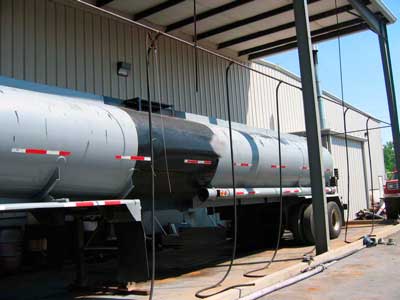 |
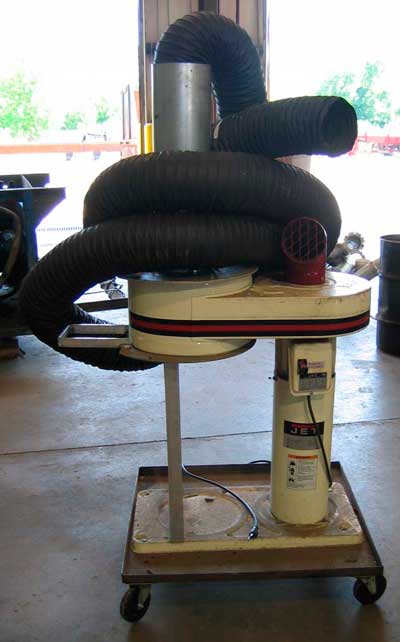 |
|
Figure 3. Example of forced air blower unit
|
The tanker remained outside for approximately 10 minutes before it was driven into the building and positioned in the second stall from the east side on the north side of the building with Compartment #1 facing out. The decedent was working on another job during the steam purging process. After the truck was inside the building, the shop foreman told the decedent to use mechanical ventilation “blown down” to cool the unit. Using a mobile steel stair unit to access the top of the tanker, the decedent placed the blower hose into Compartment #4 (Figure 3).
The shop foreman and the decedent examined the tanker to determine the leak location. While under the tanker, they noted where gas had washed down some of the pipes and saw other evidence of leaking on a cross member. Based on this visual evidence, they confirmed that the leak was in Compartment #3. Another employee was assigned to perform the maintenance on the bottom loader headers and the decedent was assigned to fix the leak.
The shop foreman instructed the decedent to take the cover off Compartment #3. The decedent took the cover off and transferred the blower hose to Compartment #3. The decedent was responsible for performing air monitoring within the compartment to check for flammable/combustible gasses prior to entering the cargo tank. The air monitor was with another employee at the time of the explosion. It is unknown if the decedent performed air monitoring prior to entering Compartment #3.
After an unknown period of time, the decedent entered Compartment #3 and visually located the leak. He indicated that there were leaks over the frame on both sides (Figure 4). The decedent exited the tank and procured grinding equipment to prepare the weld site.
After the weld site was prepared, the decedent prepared the MIG welder positioned near the blower on the west side of the tanker. The decedent appropriately grounded the welder. The decedent’s toolbox was located to the east of the tanker. Using aluminum wire and argon shielding gas, the decedent began welding. At about 11:15 a.m. to 11:30 a.m., the decedent exited Compartment #3 because he had run out of argon gas. He replaced his argon tank, reentered the compartment, and resumed welding. It is unknown if he conducted air monitoring upon reentering Compartment #3 nor did the foreman instruct the decedent to conduct air monitoring.
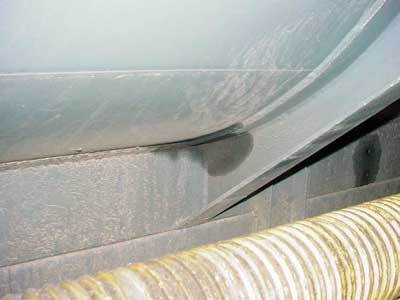 |
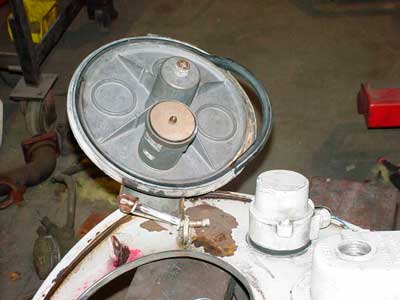 |
|
Figure 5. Condition of Compartment #4 10-inch lid after the explosion
|
While the decedent was welding, the employee responsible for maintaining the bottom loader heads was working under the tanker. This employee had taken Compartments #1, #2, and #3 loader headers off and was in the process of taking #4 bottom loader head off at the time of the explosion.
The explosion occurred approximately 15 to 20 minutes after the decedent had entered Compartment #3 to resume welding. It was determined that the explosion initiated inside Compartment #4. The tanker’s interior compartment dividers (baffles and bulkheads) were damaged. The front bulkhead and two baffles inside Compartment #4 were completely dislodged and blown forward toward Compartment #1. All of the tanker’s baffles and bulkheads were dislocated. The outside skin of the trailer was wrinkled on both the right and left side near Compartment #3 and Compartment #4. The roof of the building above the trailer had a hole in it from the explosion. Compartment #4’s tank lid was found on the roof (Figures 5 and 6 ). A three-inch diameter natural gas pipe was severely bent upward and broken into two pieces. Natural gas was spilling out of the pipe and was eventually turned off by the responding fire department. A ceiling fan above the tanker was severely damaged and was lying on the floor. A large amount of ceiling insulation was hanging from the ceiling and also on the floor due to the explosion.
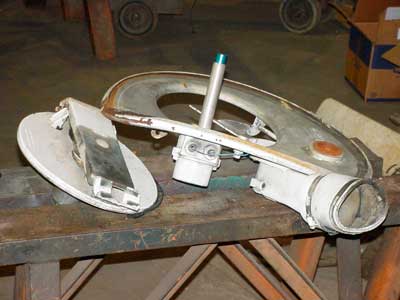 |
|
Figure 6. Condition of Compartment #4 portal covering after the explosion
|
When the explosion occurred the decedent was blown into Compartment #2. No other employees were injured in the explosion. Emergency response was called and the decedent was declared dead at the scene.
Back to Top
Cause of Death
The cause of death as stated on the death certificate was multiple blunt force injuries due to or as a consequence of an explosion in an enclosed space. Toxicology was negative for alcohol and illicit drugs.
Back to Top
Recommendations/Discussion
Employers should identify areas that are classified as a confined space and meet the requirements of a permit-required confined space (PRCS). They should then develop a written PRCS program if employees will be entering the space.
The employer did not classify the tanker compartments as a permit-required confined space but as a Hazardous Atmosphere Only spaces. Appendix A of the MIOSHA General Industry Safety Standard Part 90, Confined Space Entry and MIOSHA Occupational Health Standard Part 490, Permit-Required Confined Spaces provides a Permit-Required Confined Space Decision Flow Chart to assist employers and employees in complying with the Confined Space standards requirements. The tanker compartment met the requirements of a permit required confined space. Employees entered the compartment to initiate repairs, therefore the employer should develop and implement a permit required confined space program that includes, but is not limited to:
- Methods to prevent unauthorized entry,
- Identify and evaluate hazards prior to employee entry,
- Develop and implement the means, procedures, and practices necessary for safe permit required space entry
- operations (Entry Permit – see Appendix D of Parts 90 and 490),
- Provide necessary equipment for safe entry into and egress from the confined space,
- Test the space for atmospheric hazards,
- Provide for an attendant outside of the space,
This incident emphasizes the need to address all potential hazards in confined spaces. All employees who repair tankers should be aware of the importance of stated company safety procedures, including confined space entry policies. The employer should reinforce employee awareness of the potential hazards associated with confined spaces. The need to inform employees about the hazards of confined spaces in all respects should be a priority of the employer. Information concerning confined space entry procedures is available from several NIOSH documents including:
- Criteria for a Recommended Standard … Working in Confined Spaces – DHEW (NIOSH) Publication No. 80-106, and
- A Guide to Safety in Confined Spaces – DHHS (NIOSH) Publication No. 87-113.pdf icon
These publications are available from: Publications Dissemination DSDTT, NIOSH, 4676 Columbia Parkway, Cincinnati, Ohio 45226. Phone: (513) 841-4287.
The written PRCS should include: 1) a procedure to document boiler operation and tanker cleaning, 2) a requirement for atmospheric monitoring and forced air ventilation in adjacent compartments when conducting hot work, such as welding, within a tanker compartment, and 3) a hot work permit for confined spaces.
1) procedure to document boiler operation and tanker cleaning. Part 90 and Part 490, Section (d)(3) requires that the employer develop and implement the means, procedures, and practices necessary for safe permit space entry operations, including but not limited to the following:
- Specifying acceptable entry conditions,
- Isolating the permit space,
- Purging, inerting, flushing, or ventilating the permit space as necessary to eliminate or control atmospheric hazards
- Providing pedestrian, vehicle, or other barriers as necessary to protect entrants from external hazards, and
- Verifying that conditions in the permit space are acceptable for entry throughout the duration of an authorized entry.
The employer did not have written documentation that the boiler came to temperature, the tanker compartments came to temperature, and that the temperature in the compartments was maintained for the 90 minute purge cycle. MIFACE recommends that the employer establish a written procedure to verify proper boiler operation and tank cleaning procedures.
2) requirement for atmospheric monitoring and forced air ventilation in adjacent compartments when conducting hot work, such as welding, within a tanker compartment. Ventilation was not maintained in Compartment #4 while the decedent was welding in the forced air ventilated Compartment #3. Flammable atmospheres within a confined space generally arise from enriched-oxygen atmospheres, vaporization of flammable liquids, byproducts of work, chemical reactions, concentrations of combustible dusts, and desorption of a chemical from the confined space’s inner surface. Without ventilation being maintained in Compartment #4, a flammable atmosphere developed and the explosion occurred. When a flammable or combustible material has been transported in the tanker compartments and when hot work is conducted inside of the compartment, MIFACE recommends that continuous forced air ventilation be maintained in both the compartment where work is being performed and in the adjoining compartment(s) to reduce the likelihood of the development of a hazardous atmosphere. The position of the hose should extend the airflow to the base of the cargo hold. Flammable gases such as acetylene, butane, propane, hydrogen, methane, natural or manufactured gases or vapors from liquid hydrocarbons can be trapped in confined spaces, and since many gases are heavier than air, they will seek lower levels.
Part 90 and Part 490 Section (c)(5)(ii)(E)) requires that continuous forced air ventilation be used:
- until the forced air ventilation has eliminated any hazardous atmosphere,
- directed as to ventilate the immediate areas where an employee is or will be present within the space and shall continue until all employees have left the space,
- air supply for the forced air ventilation be from a clean source and may not increase the hazards in the space
Section F of these standards states that the atmosphere within the space shall be periodically tested as necessary to ensure that the continuous forced air ventilation is preventing the accumulation of a hazardous atmosphere. Additionally, the American National Standard Institute (ANSI) standard Z49.1: 2005 Section 7, Confined Spaces requires that confined spaces shall not be entered unless they are well ventilated and tested to assure they are safe for entry.
3) hot work permit for confined spaces. The MIOSHA Required Confined Space Standard, Section (f) lays out the requirements for an entry permit for a permit-required confined space, such as the tanker compartment. An entry permit can be considered as a record that certifies that specific precautions and procedures have been established before any person enters a confined space. The permit process provides a systematic method of verifying that all necessary checks have been carried out before the entry is authorized.
Hot work is a term used to describe heat-producing operations such as welding, flame cutting and grinding. Hot work presents two significant hazards: (1) open flames or flying sparks that can ignite flammable gases and vapors and (2) hot work that may produce toxic fumes and gases. When hot work is going to be performed in a confined space, it must be noted either on the entry permit or on a hot work permit attached to the entry permit. There are many precautions that can be taken to perform hot work in a confined space that may have the presence of an explosive or an explosive or flammable gas or vapor. Some of the precautions to take are:
- The space is purged and continuously ventilated to maintain an atmosphere of less than 5% of the LEL;
- The space is purged and continuously ventilated to maintain an oxygen concentration of less than 23%;
- The atmosphere in the confined space is continuously monitored;
- The entry permit includes adequate provisions for hot work and details the appropriate measures to be taken; and
- An alarm system and exit procedure is in place to provide adequate warning and allow safe escape if the levels in a) or b) above are exceeded. It is good practice to incorporate a safety factor that provides for adequate warning should the levels be approached.
Alternatively, the space may be rendered non-explosive by inerting with an inert gas and continuously monitoring the atmosphere, particularly with regard to oxygen concentration. If inert gas is used, workers inside the confined space must wear appropriate supplied air respiratory protective equipment and appropriate respiratory equipment must be available to persons outside the confined space to enter the space to locate and rescue them, if necessary.
Employers should review welding practices to ensure proper welding techniques are used.
The diameter of wire that the decedent was using to repair the tank’s interior is unknown. The most common diameters of welding wire are .035 inches and .045 inches. For thinner materials, a smaller diameter wire, such as a .025-inch diameter usually will create a good weld. A weld that is too large can lead to burn-through of the base material. Because a smaller diameter wire welds at a lower current, there is less arc force and a reduced tendency to burn-through the base material. For thicker materials (>3/16 inches) a smaller diameter wire would be problematic because there may be a risk of lack of fusion. Burn-through of the baffle in Compartment #3 may have been a factor in this incident. It is unknown if there was diesel fuel between the baffles of Compartment #3 and Compartment #4 or if a burn-through of both baffles occurred. Welding practices, especially within a confined space should be reviewed prior to conducting the welding operation to ensure all safe welding practices are followed.
Bulk transport trade organizations should develop a sample tank cleaning procedure that addresses the safety and health issues inherent in the tank cleaning process.
There is no specific U.S. or international standard on the safety, health and environmental aspects to be followed on cleaning road-based petroleum tankers. Environmental requirements for wastewater generated during the tank cleaning process can by found on the US Environmental Protection Agency (U.S. EPA) website: http://www.epa.gov/fedrgstr/EPA-WATER/1998/June/Day-25/w13792.htm. (Link no longer available 4/9/2015)
All truck compartments, which have recently been used for storage, transport or dispensing of flammable liquids, should be emptied, thoroughly cleaned, and purged before initiating repairs. Cleaning agents include water, steam, detergents, bases, acids, and solvents, which are applied with hand-held pressure wands or by rotating spray nozzles. Detergent, acidic, or basic solutions are usually used until spent and then sent to treatment facilities. Solvents can be recycled in a closed system, with sludges either incinerated or landfilled.
References
MIOSHA standardsexternal icon cited in this report may be found at and downloaded from the MIOSHA, Michigan Department of Labor and Economic Growth (DLEG) web site at: http://www.michigan.gov/mioshastandards. MIOSHA standards are available for a fee by writing to: Michigan Department of Labor and Economic Growth, MIOSHA Standards Section, P.O. Box 30643, Lansing, Michigan 48909-8143 or calling (517) 322-1845.
The MIOSHA Consultation Education & Training (CET) Division services are provided throughout the state by an in-house staff of professional occupational safety consultants, occupational safety specialists and industrial hygienists. The staff in the CET Division is non-enforcement personnel. These consultants and specialists are located throughout Michigan and collectively they serve the employers and the employees in all 83 Michigan counties. MIOSHA CET Divisionexternal icon can be contacted by writing to: Consultation Education and Training, 7150 Harris Drive, P.O. Box 30643, Lansing, Michigan 48909-8143 or calling (517) 322-1809. http://www.michigan.gov/lara/0,4601,7-154-61256_11407_15317—,00.html (Link updated 4/1/2013)
- MIOSHA General Industry Safety Standard, Part 90, Confined Space Entry
- MIOSHA Occupational Health Standard, Part 490, Permit-Required Confined Space
- MIOSHA Occupational Health Standard, Part 529, Welding, Cutting and Brazing
- MIOSHA Occupational Health Standard, Rule 3303, Specific Operations and Special Industries
- NIOSH FACE Report 8830. Laborer Dies in Explosion. https://www.cdc.gov/niosh/face/in-house/full8830.html
- California FACE Investigation 93CA009, April 5, 1994. Welder Dies in Explosion While Working Inside a Tanker Trailer in California.
https://www.cdc.gov/niosh/face/stateface/ca/93ca009.html - NIOSH Safety and Health Topic: Confined Spaces. https://www.cdc.gov/niosh/topics/confinedspace/
- DHHS (NIOSH) Publication No. 94-103. Worker Deaths In Confined Spaces. A Summary Of NIOSH Surveillance And Investigative Findings. January, 1994. https://www.cdc.gov/niosh/docs/94-103/ (Link updated 3/25/2013)
- NIOSH ALERT January 1986. DHHS (NIOSH) Publication No. 86-110. Request For Assistance In Preventing Occupational Fatalities In Confined Spaces. https://www.cdc.gov/niosh/docs/86-110/ (Link updated 3/25/2013)
- American Welding Society. Confined Spaces – Safety and Health Fact Sheet No. 11. September 1995. http://files.aws.org/technical/facts/FACT-11.pdf (Link updated 9/23/2009 – no longer available 4/9/2014)
- Princeton University. Confined Spaces. external iconhttp://web.princeton.edu/sites/ehs/consafadv/confined.htm
- Lincoln Electric. Frequently Asked MIG Welding Questions.external icon http://www.lincolnelectric.com/en-us/support/Pages/faq.aspx (Link updated 3/25/2013)
- Miller Electric Manufacturing. GMAW (MIG) Aluminum Welding Hints.external icon http://www.millerwelds.com/resources/articles/index?page=articles10.html (Link updated 8/5/2009)
- Ontario Ministry of Labour, Health and Safety. Hot Work – Confined Spaces Guidelines.external icon http://www.labour.gov.on.ca/english/hs/pubs/confined/cs_14.php (Link updated 11/17/2009)
Michigan FACE Program
MIFACE (Michigan Fatality Assessment and Control Evaluation), Michigan State University (MSU) Occupational & Environmental Medicineexternal icon, 117 West Fee Hall, East Lansing, Michigan 48824-1315. Internet Address: http://www.oem.msu.edu/MiFACE_Program.aspx. This information is for educational purposes only. This MIFACE report becomes public property upon publication and may be printed verbatim with credit to MSU. Reprinting cannot be used to endorse or advertise a commercial product or company. All rights reserved. MSU is an affirmative-action, equal opportunity employer. 4/25//08 (Link updated 8/5/2009)
MIFACE Investigation Report # 06MI188 Evaluationpdf iconexternal icon (see page 12 of report)
To contact Michigan State FACE program personnel regarding State-based FACE reports, please use information listed on the Contact Sheet on the NIOSH FACE web site Please contact In-house FACE program personnel regarding In-house FACE reports and to gain assistance when State-FACE program personnel cannot be reached.
